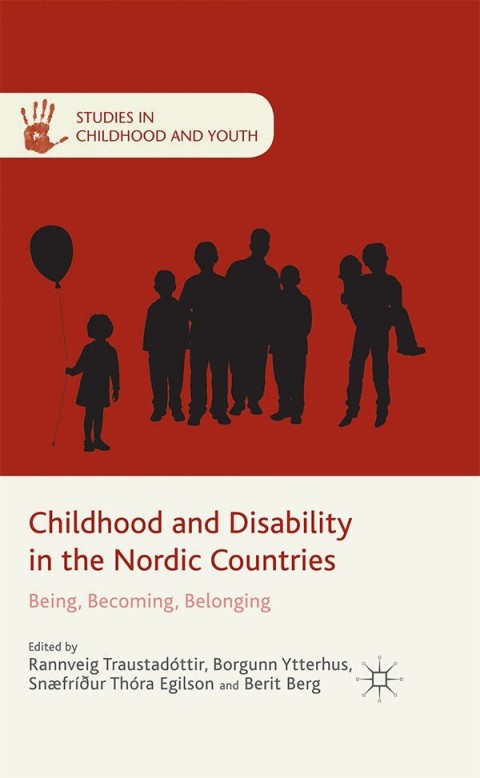Description
Efnisyfirlit
- Cover Page
- Title Page
- Copyright
- Contents
- List of Tables
- List of Figures
- Foreword
- Tom Shakespeare
- Acknowledgements
- Notes on Contributors
- Introduction: Disabled Children and Youth in the Nordic Countries
- Snæfrídur Thóra Egilson, Borgunn Ytterhus, Rannveig Traustadóttir and Berit Berg
- Why this book?
- Theoretical foundations
- Nordic welfare and disability policies
- Organisation and content of the book
- Note
- References
- Part I: Theories and History
- 1 Perspectives on Childhood and Disability
- Borgunn Ytterhus, Snæfrídur Thóra Egilson, Rannveig Traustadóttir and Berit Berg
- Theoretical and conceptual underpinnings
- Disabled children’s perspectives and experiences
- Future directions
- References
- 2 Disabled Children and Welfare Policy in the Nordic Countries: Historical Notes
- Jan Tøssebro
- Two fundamental changes
- Three discourses
- After normalization – trends from the 1970s to the 1990s and beyond
- References
- 3 Inclusion, Diagnostics, and Diversity: Ethical Considerations
- Simo Vehmas
- Introduction
- Disability as an ethical and political issue
- Capabilities and inclusion
- Diagnostics, medicalization, and moral responsibility
- Conclusion
- References
- Part II: Identity and Images
- 4 ‘I Am Different, But I’m Like Everyone Else’: The Dynamics of Disability Identity
- Anders Gustavsson and Catarina Nyberg
- Disability and identity – from dichotomies to dynamics
- The family and ‘the first generation of integration’ in Sweden
- Taking the normalization and integration policy seriously
- The family as a supportive space for positive self-identifications
- Multiple identifications
- Sven’s self-identifications
- Positive self-identifications
- Normal, but thinks in a different way
- Explaining, proving and defending self-identifications
- Multiplicity, fluidity and continuity
- The dynamics of disability identity
- Notes
- References
- 5 Childhood Disability, Identity and the Body
- Eiríkur Smith and Rannveig Traustadóttir
- Identity and the body
- The research
- Childhood disability
- Entering the teenage years
- Experiencing differentiation
- Embodied obstacles and explorations
- Conclusion
- References
- 6 Ethnicity, Disability, and Identity
- Anna M. Kittelsaa
- Introduction
- The study: immigrant families with disabled children in Norway
- Parents’ narratives about identity
- Individual identity and disability
- Identifying children with severe impairments
- Ethnic identity and disability
- The importance of belonging to a family
- Professional narratives
- Professionals’ narratives about identity and disability
- Professionals’ narratives about ethnicity
- Conclusion
- References
- 7 Cultural Representation of Disability in Children’s Literature
- Hanna Björg Sigurjónsdóttir
- Icelandic folk tales
- Translated fairy tales and fantasy literature
- Classic children’s books
- More realistic books
- Discussion: images of disability
- References
- Children’s books
- Part III: Interaction and Inclusion
- 8 Social Inclusion as a Theoretical Concept and a Social Practice
- Karin Barron
- Introduction
- The emergence of ‘social inclusion’ as a significant concept
- A question of power
- Claiming social inclusion on one’s own terms
- All the children contributing
- Playing alone, but not necessarily lonely
- The complexity of identity
- Gendered pathways
- Interests and gendered agency
- References
- 9 Does One Size Fit All? Physical Placement, Organizational Structure, and Parental Satisfaction in Norwegian Day Care Centres
- Borgunn Ytterhus
- Introduction
- Nordic welfare and day care for children
- Data and analysis
- Major political changes – few empirical changes
- What characterizes the day care centres where parents and staff are most satisfied?
- Discussion
- Note
- References
- 10 Trendsetters and Followers: Disabled Young People’s Computer Use during Leisure Time
- Helena Hemmingsson
- The digital generation
- Information Communication Technology and impairments
- The digital divide
- Surveying young people’s media habits
- Young people’s use of ICT in 2006
- Different views on the results
- Trendsetters and followers
- In search of explanations
- Concluding remarks
- Note
- References
- 11 A Comparison of Social Life among 11-Year-Old Disabled Children and 11-Year-Olds in General
- Maria Lomborg Røgeskov, Helle Hansen and Steen Bengtsson
- Children’s development and social relations
- Method
- Disabled children
- Social life outside school
- School and social life
- Bullying
- Friendship and peer relations
- Conclusions and perspectives
- Notes
- References
- Part IV: Families and Services
- 12 Ordinary or Not? Families of Children Growing Up with Disabilities
- Jan Tøssebro and Christian Wendelborg
- Ordinary families?
- Family experiences with the service system
- Conclusions
- References
- 13 Immigrant Families with Disabled Children in Norway
- Berit Berg
- Introduction
- The study: immigrant families with disabled children in Norway
- Survey methods and ethical considerations
- Family attitudes towards disability
- Sameness and differences
- Stereotypes, misunderstandings, and myths
- Interactions with the service system
- A demanding situation
- Conclusion
- Note
- References
- 14 User Perspectives on Support Services to Disabled Children and Their Families
- Snæfrídur Thóra Egilson
- Eliciting family perspectives and priorities
- Measuring processes of care
- What parents think and want
- Children’s and adolescents’ views
- Discussion and implications
- References
- Concluding Remarks
- Borgunn Ytterhus, Snæfrídur Thóra Egilson, Rannveig Traustadóttir and Berit Berg
- Increased emphasis on disabled children
- Importance of families
- Human rights perspectives
- Social inclusion and exclusion
- Future challenges of the Nordic welfare states
- References
- Index






Reviews
There are no reviews yet.